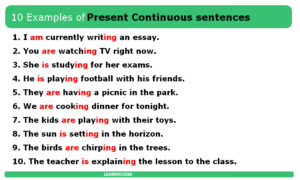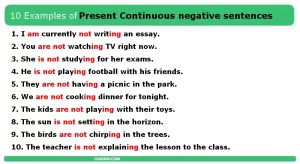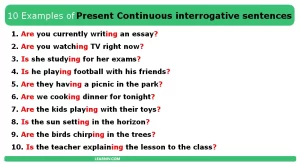The Present Continuous, also known as the Present Progressive, is an English verb tense used to talk about actions that are in the process of being carried out at the time of speaking. This verb tense is formed with the verb “to be” followed by the verb in the gerund (-ing).
There are many English verbs that are used in the Present Continuous, but here are 100 of the most common ones:
100 English Present Continuous verbs
- be – being
- have – having
- do – doing
- say – saying
- go – going
- can – being able to
- get – getting
- make – making
- know – knowing
- see – seeing
- come – coming
- think – thinking
- look – looking
- want – wanting
- give – giving
- use – using
- find – finding
- tell – telling
- ask – asking
- work – working
- seem – seeming
- feel – feeling
- try – trying
- leave – leaving
- call – calling
- need – needing
- feel – feeling
- become – becoming
- mean – meaning
- keep – keeping
- let – letting
- begin – beginning
- seem – seeming
- help – helping
- talk – talking
- turn – turning
- start – starting
- show – showing
- hear – hearing
- play – playing
- run – running
- move – moving
- like – liking
- live – living
- believe – believing
- hold – holding
- bring – bringing
- happen – happening
- write – writing
- provide – providing
- sit – sitting
- stand – standing
- lose – losing
- pay – paying
- meet – meeting
- include – including
- continue – continuing
- set – setting
- learn – learning
- change – changing
- lead – leading
- understand – understanding
- watch – watching
- follow – following
- stop – stopping
- create – creating
- speak – speaking
- read – reading
- allow – allowing
- add – adding
- spend – spending
- grow – growing
- open – opening
- walk – walking
- win – winning
- offer – offering
- remember – remembering
- love – loving
- consider – considering
- appear – appearing
- buy – buying
- wait – waiting
- serve – serving
- die – dying
- send – sending
- expect – expecting
- build – building
- stay – staying
- fall – falling
- cut – cutting
- reach – reaching
- kill – killing
- remain – remaining
- suggest – suggesting
- raise – raising
- pass – passing
- sell – selling
- require – requiring
- report – reporting
- decide – deciding
Some verbs are not typically used in the present continuous tense because they represent states, qualities, or non-action verbs. These verbs describe conditions or characteristics that are not usually associated with ongoing or temporary actions. We will deal with them in a separate article: Verbs in the English Present Continuous (progressive).
Explanation of the Present Continuous
These verbs are commonly used in the present continuous to describe what is happening at the present moment.
The present continuous can also be used to talk about actions that are in the process of taking place but are not necessarily happening at the present moment. For example, “He is studying for his exam”.
The present continuous is also used to describe actions that are scheduled or planned in the near future. For example, “I am meeting my friend tomorrow”.
It is important to note that the present continuous is a verb tense in English that is used to describe actions that are in the process of taking place at the time of speaking. Therefore, it is not used to describe actions that occur regularly or that are habits.
In conclusion, the present continuous is an English verb tense that is used to describe actions that are in the process of being performed at the time of speaking. The 100 verbs mentioned above are some of the most common verbs used in this tense. I hope this information will be useful in improving your understanding of the present continuous tense in English.
More examples of Present Continuous sentences
- Other examples of the present continuous.
- 10 sentences in the present continuous
- 20 sentences in the present continuous
- 30 sentences in the present continuous
- 50 sentences in the present continuous
- 100 sentences in the present continuous
- General sentences in the present continuous
- Present continuous passive voice
- Present continuous tense structure


